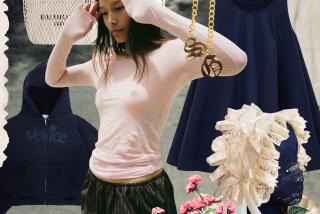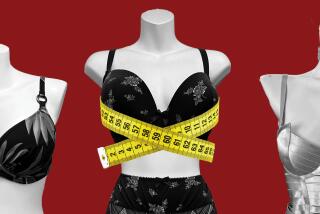FASHION : Expanding the Options : Many maternity clothes are ill-fitting and frumpy. But the styles, they may be a-changin’.
- Share via
“Most pregnant women do not look good in clothes,” says Yasmin Le Bon, a New York fashion model who recently joined the tiny clutch of celebrities who have posed nude during their pregnancies.
Of course, most pregnant women don’t have the option of cruising around in the buff, so they must endure the indignities of maternity clothes. In general, moms-to-be say, such garments are pricey, ill-fitting and unstylish. To add insult to injury, many department stores have eliminated their maternity areas.
But there is hope for women who dread the “big blouse with a big bow underneath a big jumper” look. A handful of specialty stores and designers offer outfits that would please any fashion maven--no matter what month she’s in. And at least one department store chain is planning to expand its offerings at selected stores.
Many women don’t have kind words for traditional maternity wear. “The woman who is getting pregnant today doesn’t need to look like a Kewpie doll wearing Peter Pan collar-enhanced dresses,” says Stephanie Young, author of the “Your Pregnancy” column in Glamour magazine. “Those are the kinds of things reinforcing the ‘Gee, I’m frumpy, maybe I don’t deserve to wear real fashion’ way of thinking.”
“Most maternity clothes I see are just obnoxious looking,” says pregnant model Ivy Timewell. “It’s like they think you lose all your sophistication. Nothing has any structure at all, and most make you look a lot bigger than you are.” The 26-year-old Newport Beach resident, like many pregnant women, says the mere mention of maternity clothes prompts negative images of ribbon-laden T-shirts, bow-happy dresses and sailor ensembles.
Expectant mother Wendy Manasse-Wiese, a Los Angeles swimsuit designer who’s in her fifth month, recently endured the trials of finding suitable attire for an elegant soiree in New York City. She strolled through one local maternity shop and says she couldn’t find a single garment she would wear. So Manasse-Wiese bought a gold tunic top in a larger ready-to-wear size to wear as a dress and a maternity full slip at the boutique to prevent clinging.
“Even the slip is nerdy,” she complains, adding that because she prefers short skirts, she had to cut eight inches off the slip.
(Manasse-Wiese says hosiery selection is another problem. She prefers opaque tights but has been unable to find them in maternity sizes. Her solution: She sews the legs of panty hose to the panty portion of maternity hose.)
Mothers-to-be also face other shopping woes: They can’t rely on the convenience of department store shopping. Most major department stores--I. Magnin, The Broadway, Robinson’s, Saks Fifth Avenue and Neiman Marcus among them--don’t carry maternity clothing. The May Co. features a few racks of maternity wear in its large-size apparel department, but the area is poorly merchandised (clothes are traditional in styling) and difficult to distinguish.
Nordstorm may be the only local chain adding maternity wear. Starting Sept. 6, the South Coast Plaza, Brea and Riverside stores will feature maternity wear in the stores’ Point of View departments.
Buyer Kelly McLeod says customer demand prompted the addition. And she agrees that the selection of maternity wear could be better: “I was kind of surprised when I first started looking for maternity clothing for the departments. I tried to put myself on the line, thinking all the while, ‘Would I wear this if I was pregnant?’ The fact is, while I found some nice things, the selection (I) have to choose from could be a lot better.”
In Southern California, specialty stores have the maternity business wrapped up. There are a handful of boutique chains--Motherhood, Mother’s Work, Page Boy, Pea in the Pod, Reborn Maternity--as well as a few independent operations, such as Style for Two in Newport Beach, Maman in Santa Monica and 2B2 in Los Angeles. The styles they offer range from ultra hip to hopelessly hideous.
Maman, on Montana Avenue in Santa Monica’s trendy shopping district, is an upscale boutique. This tiny store features exclusive, imported Italian and French sportswear, activewear, sleepwear and special occasion dresses. There is an abundance of short slim skirts and other garments that can easily be altered after pregnancy. Prices range from $45 for a pair of leggings to $600 for an evening dress.
2B2 offers a variety of lines at up to 50% to 70% off. Stylishness prevails. There are snap-crotch T-shirt style bodysuits for $24, leggings and even evening wear.
Glamour columnist Young says the selection of maternity clothing has improved since she was pregnant a few years ago. Among the designers she credits with upgrading the options are Charlotte Neuville and Jennifer George. Still, she admits she still sees “a lot of junk.”
Nordstrom buyer McLeod says most of what she finds is either too youthful or too functional. She says stylish exceptions include Japanese Weekend, Haley Michaels and Travis Jeans, a line similar in styling to Levi’s 501s.
At Modern Maternity Sales showrooms in Los Angeles’ California Mart and San Francisco’s Fashion Center, buyers for specialty and department stores can select from 18 maternity wear lines. Showroom owner Joyce Tucker says her most popular lines include Japan Weekend; Oliver Pease, which she calls the Liz Claiborne of maternity fashions, and Zoe Harrison, an Australian line manufactured in the United States.
When pregnant women do find clothing they like, many complain about steep price tags. Designer and mom-to-be Manasse-Wiese says the maternity slip she purchased and the maternity underwear she has seen in stores is more expensive than what she usually buys and is not as stylish. But maternity wear manufacturers say it’s tough to be competitive.
“You have to understand there is more fabric in a maternity garment and that costs money,” says Robert Pollock, chief operating officer of Dallas-based Page Boy.
“Also, when you look at a $19 T-shirt at The Gap, there is no point in us trying to compete with that,” he says. “They are making a million of them, and we just don’t have or even want that kind of cookie-cutter volume.” Pollock adds that Page Boy garments are made in the United States, a more expensive undertaking than relying on import labor employed by many other ready-to-wear lines.
Despite the handful of reliable manufacturers and retail sources, some women still refuse to wear maternity clothing. Bella Shaw, co-anchor of CNN’s “Showbiz Weekly,” is almost six months pregnant and has yet to don a maternity frock.
Shaw, who says she shopped maternity stores in vain, is wearing regular clothing for her on-air appearances. The current trapeze shapes, A-line cuts and other au courant shapes work well for the thirtysomething anchor. At home, Shaw says she frequently wears her husband’s clothes.
But showroom owner Tucker says she thinks expectant mothers make a big mistake when they try to wear standard ready-to-wear clothes throughout their pregnancies.
“Women who . . . try to wear regular clothes can’t wear them to full term, so they might as well buy a few maternity clothes. After a while, jackets and dresses start hiking up in the front, and the ill-fitting garments don’t look very good,” she says.
Shaw admits fashion changes are in the wind for her at the CNN “Showbiz” desk. Standard jackets are becoming too snug for comfort.
She says: “I’m afraid I’m going to have to break down and buy some of it.”






